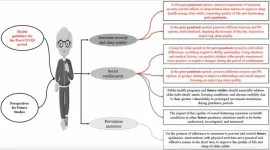(Press-News.org) Images
Elad Harel is used to shining a light on the mysteries of the natural world.
Working at the cutting-edge of ultrafast spectroscopy — the application of short laser pulses to analyze the dynamics of molecules — the Michigan State University associate professor’s research aims to reveal how microscopic phenomena impact large complex systems.
One promising frontier Harel has been working on is the development of new methods of microscopy that will allow researchers to observe molecular and atomic landscapes in motion rather than through static imagery. Such work has earned Harel MSU’s 2023 Innovation of the Year award, as well as MSU’s first-ever grant from the W.M. Keck Foundation.
Now, in a new publication appearing in the Proceedings of the National Academy of Sciences, Harel and his Spartan collaborators report using light to observe and study the “sound” of a virus — an auditory breakthrough that provides a glimpse into elusive, real-time biology.
Harel’s lab worked closely with Dohun Pyeon, a professor in MSU’s Department of Microbiology, Genetics and Immunology, or MGI, who lent his group’s expertise in providing virus targets.
“Teamwork really matters in this challenging and exciting project, and it’s fascinating to experimentally observe the nanoscale motion of these tiny virus particles — they are actually ‘breathing’ under laser illumination,” said Yaqing Zhang, a postdoctoral researcher in the Harel lab and first author of the study.
“I am confident that this technique can be widely utilized for millions of viruses and other biological samples and will acquire more invaluable information from them. The more we know them, the better we can prepare for the next pandemic,” Zhang added.
The College of Natural Science caught up with Harel to learn more about this discovery and a process he calls BioSonic spectroscopy.
This conversation has been edited for length and clarity.
Not many people would string together the words “virus,” “light” and “listen” in a sentence. Could you talk a bit about the fundamental science behind this discovery?
Every type of system has a natural vibrational frequency, whether it’s a star or a biological entity like a virus. You can think of it as the sound the material has, whereby all the atoms vibrate together like balls connected by a complex network of springs.
The arrangement of atoms and their interactions is why when I bang on a table, it sounds different than if I bang on a wall. Of course, sound can be much more complex and contain important information: If you hear a familiar voice across the room, you can immediately identify who it is coming from. Sound, therefore, is a powerful means of identification.
Researchers have been looking at ultrasonic vibrations of metal nanoparticles for several years, but we wanted to ask the question, ‘Do biological systems produce a sound when experiencing some force?’
To initiate the sound, we use short pulses of light that generate coherent motion in the system. We then use a second pulse of light to probe that motion at different moments in time. By stringing together all the snapshots in time, we can produce a molecular movie that captures the vibrational motion of the object.
This was a kind of far-out idea, and there wasn’t really any precedent for it, and we discovered that viruses do have a unique sound, which opens a whole new way of thinking about biology.
Whether it’s a virus, a protein, bacteria or the nucleus of a cell — each one will have this unique signature we can detect.
Why did “listening” to a biological system seem like an effective approach compared to other methods of analysis?
We were trying to tackle a fundamental problem in biology, which was also the focus of our Keck Foundation grant — to get the resolution of electron microscopy, but for living systems.
Electron microscopy, or EM, itself is very powerful, but you’re really taking snapshots of life, and you’re doing it in an environment that’s quite different than what you find in living organisms. EM is done in vacuum, and with cryo-EM, it is done at very low temperatures where life cannot be sustained. The goal of the Keck grant was to develop microscopy methods that can visualize and track biology in the hot and wet environment where living things operate.
We spent several years developing more and more sensitive techniques that can measure acoustic vibrations, especially at the single particle level. This was in collaboration with the Pyeon lab in MGI, which helped us gain access to different viruses.
The bigger picture was also thinking of how this acoustic approach could be used as a powerful imaging probe without the need for labeling. This is the process in which a marker is attached to a molecule, allowing researchers to track and study its behaviors and interactions. While extremely useful and specific, the labeling process can be slow and intensive.
One of our goals is to show that this new methodology could use a virus’s or molecule’s natural labeling — basically, the sound of its own materials that distinguishes it from everything else in a system.
So, what did these viruses end up sounding like? Do they ever change their tune?
It turned out the vibrations occur in the gigahertz region. This is a very, very low frequency from the point of optical transitions. For instance, visible light is in the hundreds of terahertz, so these are thousands to millions of times lower energy than what we typically think of in terms of optical spectroscopy.
In this paper, we showed that we can track single viruses and even listen to a virus rupture. As the virus begins to break open and weaken, its acoustics start to change, going lower — almost like a deflating balloon.
What does the future look like for these discoveries?
What we want to do next is show that we could actually dynamically track how a virus is moving. If we want to watch a virus go into a cell now, the process is very, very challenging and slow via electron microscopy or utilizing complex fluorescence labeling.
For example, we have a grant with the Defense Threat Reduction Agency that is interested in biological and chemical detection. One of the things they do is develop drugs, or antivirals, for combating viral infections.
The thinking is: Can we use this kind of technique to speed up that development process — because we could potentially watch a virus’s life cycle from start to finish and better understand the influence of antivirals or drugs in disrupting that process.
By Bethany Mauger and Connor Yeck
###
Michigan State University has been advancing the common good with uncommon will for 170 years. One of the world’s leading public research universities, MSU pushes the boundaries of discovery to make a better, safer, healthier world for all while providing life-changing opportunities to a diverse and inclusive academic community through more than 400 programs of study in 17 degree-granting colleges.
For MSU news on the web, go to MSUToday or x.com/MSUnews.
END
MSU expert: Using light to hear biology
2025-02-11
ELSE PRESS RELEASES FROM THIS DATE:
“I can’t hear you, I’m too stressed”: Repeated stress in mice reduces sound perception
2025-02-11
After a week of stress, mice show changes in how their brains process sound, reducing how well they perceive loud noises, according to a study published February 11th in the open-access journal PLOS Biology led by Ghattas Bisharat, from the Ben-Gurion University of the Negev in Israel, and colleagues.
Repeated stress has negative impacts on mental health that can go beyond psychiatric disorders. They can also cause changes in how we perceive the world, making us jump at loud noises, or become easily irritated by scratchy sweaters or offensive odors. To understand how repeated stress can impact how the brain processes sensory information, the authors ...
Chronic stress affects how brain processes sound in mice
2025-02-11
BEER-SHEVA, Israel, February 11, 2025 – Chronic stress changes the way our brain processes sounds, according to new research conducted on mice at Ben-Gurion University of the Negev. For instance, sounds need to be louder during chronic stress to trigger similar responses.
Chronic stress is known to impact learning and decision-making, but could it also affect how we hear? Dr. Jennifer Resnik from Ben-Gurion University’s Department of Life Sciences set out to find whether stress influences basic brain functions, ...
Insilico Medicine announces developmental candidate benchmarks and timelines for novel therapeutics discovered using generative AI
2025-02-11
Cambridge, MA – Insilico Medicine ( “Insilico”) , a clinical stage generative artificial intelligence (AI)-driven biotechnology company today announced a set of preclinical drug discovery benchmarks from the 22 developmental candidate nominations achieved by its platform from 2021 to 2024. These benchmarks underscore the platform's efficiency and represent a potential new standard for the drug discovery industry by significantly reducing developmental times, cost, and by allowing resources to be redirected toward further ...
A wealth of evidence: PIK compiles 85,000 individual studies about climate policy
2025-02-11
“Rather than directly providing answers to questions about the effects of climate policies, this study displays an overview of what has actually been scientifically studied so far,” explains Max Callaghan, PIK researcher and lead author of the study. “On the one hand, this informs existing gaps and thus directions for primary research, including through funding. On the other hand, this overview facilitates evidence synthesis work, i.e. the summarisation of the state of knowledge for governments, for example in the IPCC Assessment Reports.”
The study shows, among other ...
New fish species with ‘face paint’ named after Studio Ghibli character
2025-02-11
Researchers in China have named a newly discovered fish species after the Studio Ghibli character San from Princess Mononoke based on its similar facial markings.
Published in the open-access journal ZooKeys, Branchiostegus sanae is a deepwater tilefish belonging to the family Branchiostegidae. It was discovered when scientists noticed unique cheek pattern on some deepwater tilefish individuals in online seafood markets.
The research team used genetic analysis to confirm the new-species status of the fish, and were inspired by its facial stripes to name it after the female protagonist, San, from Hayao Miyazaki’s animated film Princess Mononoke, choosing “sanae” ...
Mechanical heart valve replacements have better long-term survival, study finds
2025-02-11
Patients aged between 50 to 70 years with a mechanical heart valve replacement had better long-term survival compared to those with a biological valve, new research led by the University of Bristol has found. The study is published in the European Journal of Cardio-Thoracic Surgery.
The last two decades have seen an increase in the use of biological over mechanical heart valve replacements. However, while short-term clinical outcomes are known to be the same, long-term outcomes are still under debate.
Existing guidelines support the use of mechanical valves made of synthetic ...
Sandra Diaz and Eduardo Brondízio, scholars of human-nature interconnection, win the 2025 Tyler Prize with call for policies, business models and individuals to recognize humanity’s 'entanglement' wit
2025-02-11
FEBRUARY 11, 2025 – Argentine ecologist Sandra Díaz and Brazilian-American anthropologist Eduardo Brondízio are being awarded the 2025 Tyler Prize for Environmental Achievement for their extraordinary work linking biodiversity to humankind, the Tyler Prize Executive Committee announced today.
Díaz and Brondízio are using the win to draw attention to humanity’s “entanglement” with nature in a joint call for policies, business models, and individuals to acknowledge their dependence and shared responsibility in the “fabric of life.”
“The ...
Kessler Foundation in partnership with Overlook Medical Center is first in NJ to implant novel spinal stimulator
2025-02-11
East Hanover & Summit, NJ – February 11, 2025 – The Tim and Caroline Reynolds Center for Spinal Stimulation at Kessler Foundation is proud to announce the implantation of a spinal cord epidural stimulator in an individual with paralysis, marking a significant advancement in spinal cord injury treatment and rehabilitation. The surgical procedure was funded by the Joseph and Cheryl Marino Family Foundation and performed by neurosurgeon Robert F. Heary, MD, at Overlook Medical Center in Summit, NJ, part of Atlantic Health System, home of the Atlantic Neuroscience Institute.
This groundbreaking procedure, ...
Study reveals how physical activity impacts sleep quality in older adults during COVID-19 pandemic
2025-02-11
“[…] we found that PA may be associated with the sleep quality of older adults during the COVID-19 pandemic and that reduced levels of PA during the COVID-19 pandemic period had a negative association with the quality of sleep of older adults in social isolation.”
BUFFALO, NY—February 11, 2025 — A new research paper was published in Aging (Aging-US) on January 15, 2025, in Volume 17, Issue 1, titled “Association between physical activity practice and sleep quality of older people in social isolation during the COVID-19 pandemic and Health Guidelines and future studies ...
ADHD symptoms and later e-cigarette and tobacco use in youths
2025-02-11
About The Study: In this cohort study of U.S. youths, attention-deficit/hyperactivity disorder (ADHD) symptoms were associated with the onset of nicotine and tobacco use. The findings highlight the importance of early diagnosis and effective treatment of ADHD to alleviate symptoms and reduce the risk of later nicotine and tobacco use.
Corresponding Author: To contact the corresponding author, Sean Esteban McCabe, PhD, email plius@umich.edu.
To access the embargoed study: Visit our For The Media ...




